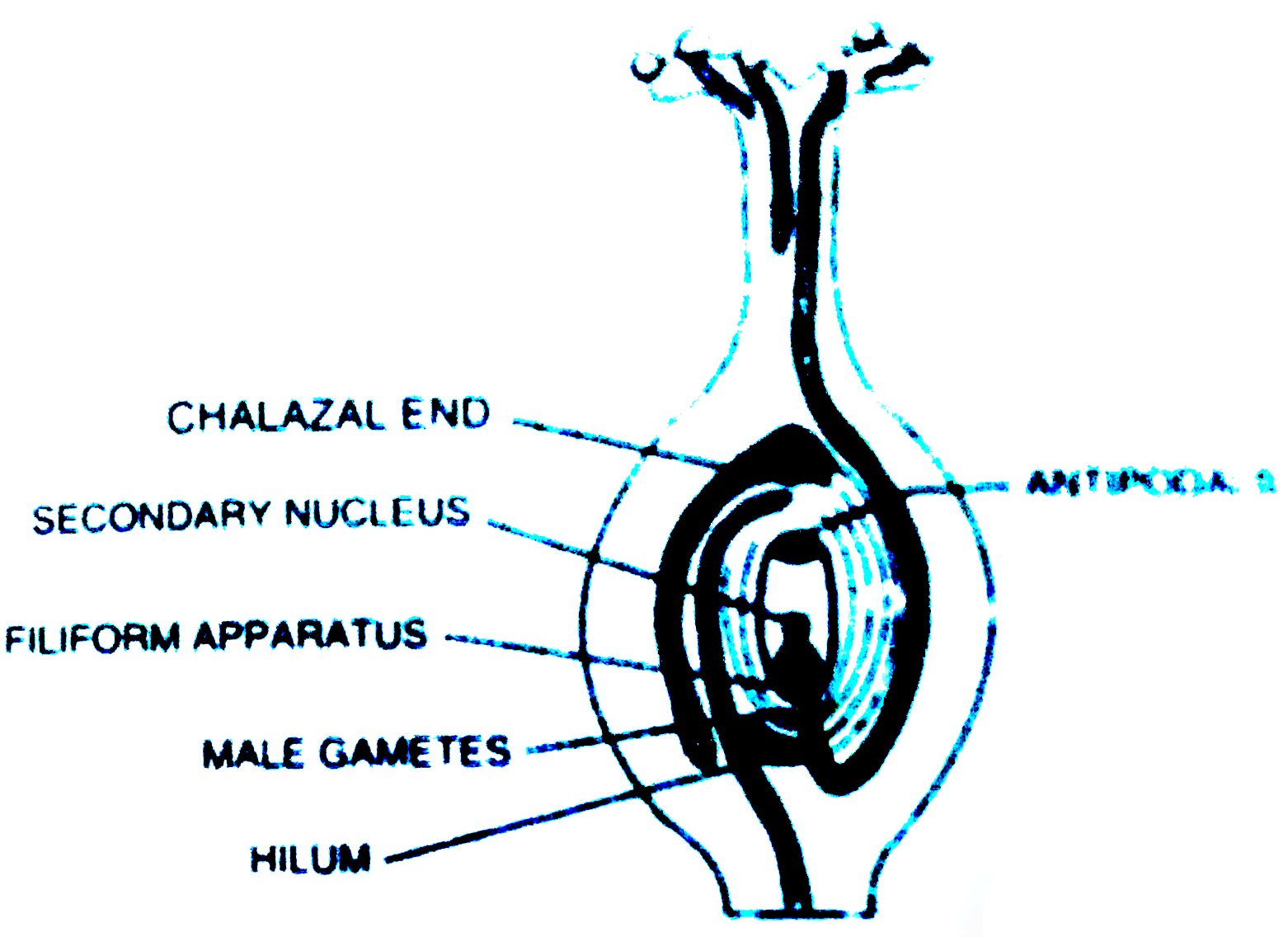Draw a longitudinal section of a post-pollinated pistil showing entry of Pollen, tube into a mature embryo-sac. Label filiform apparatus, chalazal end, Hilium, antipodals, male gametes and secondary nucleus.
Step-by-Step Solution:
1. Draw the Outline of the Pistil: Start by drawing the longitudinal section of a pistil. This should include the ovary, style, and stigma. The ovary is the part where the embryo sac is located.
2. Indicate the Entry of the Pollen Tube: Draw a pollen tube entering the ovary. The pollen tube should be shown extending from the stigma down through the style into the ovary.
3. Draw the Mature Embryo Sac: Inside the ovary, draw the mature embryo sac. This should be an elongated structure that represents the female gametophyte.
4. Label the Filiform Apparatus: At the entrance of the pollen tube, indicate the filiform apparatus. This structure helps guide the pollen tube towards the embryo sac.
5. Label the Chalazal End: Identify and label the chalazal end of the embryo sac, which is the end opposite the micropyle.
6. Label the Hilum: Mark the hilum, which is the point of attachment of the ovule to the ovary wall.
7. Draw and Label Antipodals: Within the embryo sac, draw three antipodal cells at the opposite end from the micropyle. Label them accordingly.
8. Indicate Male Gametes: Inside the pollen tube, draw two male gametes (sperm cells) that will travel to fertilize the egg and the secondary nucleus.
9. Label the Secondary Nucleus: Inside the embryo sac, indicate the secondary nucleus, which is formed by the fusion of one male gamete with the two polar nuclei.
10. Final Touches: Ensure all parts are clearly labeled and the diagram is neat. You may want to use different colors for better visualization.
Topper's Solved these Questions
- XII BOARDSBOOK - XII BOARD PREVIOUS YEAR PAPER ENGLISHCHAPTER - XII BOARDSEXERCISE - SECTION-D
49 Videos
- XII BOARDSBOOK - XII BOARD PREVIOUS YEAR PAPER ENGLISHCHAPTER - XII BOARDSEXERCISE - SECTION -A
11 Videos
- XII BOARDSBOOK - XII BOARD PREVIOUS YEAR PAPER ENGLISHCHAPTER - XII BOARDSEXERCISE - SECTION-B
81 Videos
- SAMPLE PAPER 2019BOOK - XII BOARD PREVIOUS YEAR PAPER ENGLISHCHAPTER - SAMPLE PAPER 2019EXERCISE - Section E Part B
3 Videos
Similar Questions
Draw a longitudinal section of a post-pollinated pistil showing entry of pollen tube into a mature embryo-sac. Label filiform apparatus, chalazal end, hilum, antipodals male gametes and secondary nucleus .

View SolutionDraw a well labelled diagram of the longitudinal section of a pistil showing pollen germination .
View SolutionEntry of pollen tube into the embryo sac takes place from a. Chalazal end b. Micropylar end c. Integuments
View SolutionDraw a labelled diagram of the longitudinal section of the maize grain to show the structure of mature embryo.
View Solution(a) Draw the longitudinal section of a flower showing growth of pollen tube upto the embryo sac.Label the following parts :
(i) Stigma
(ii) Pollen tube
(iii) Integument
(iv) Chalazal end
(v) Nucelllus
(vi) Synergids
(b) What is double fertilisation in Angiosperms? Why is it so called ?
View SolutionFunction of guiding and attracting pollen tube is done by
(a) Egg cell
(b) Filiform apparatus
(c) Antipodal cells
(d) Secondary nucleus
View SolutionDraw a labelled diagram of a mature embryo sac. Why does a pollen grain possesses two male gametes? Explain.
View SolutionDraw a longitudinal section of the pistil from a flowering plant, where pollination has occurred. Label the following: (a) Stigma showing germinating pollen grains (b) Style (c) Pollen tube reaching the micropyle of the ovule (d) Embryo sac (e) Components of the egg apparatus
View SolutionDescribe longitudinal section of a pistil showing pollen germination. Explain the events in the embryo sac during the process of fertilisation. Which resulting stages give rise to the embryo and the endosperm respectively?
View Solutiona) Draw a L.S. of a pistil showing pollen tube entering the embryo-sac in an angiosperm and label any six parts other than stigma, and ovary.
b) Write the changes a fertilized ovule undergoes within the ovary in an angiosperm plant.
View Solution
